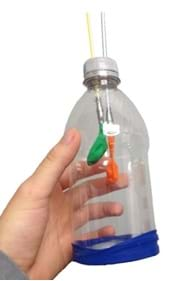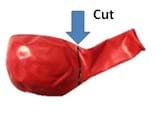Quick Look
Grade Level: Elementary school
Time Required: 45 minutes
Expendable Cost: US $0.50
Group Size: 2
Subject Areas: Biology
Introduction
Bolded words are vocabulary and concepts to highlight with students during the activity.
What is the purpose of our lungs? They exist so we can breathe. But, the lung is not a muscle, so how does it pull air in? The diaphragm is a muscle located at the bottom of your thoracic cavity, also known as your chest cavity. The diaphragm, along with the muscles between your ribs, expands your rib cage. This increases the volume (capacity) of your lungs while decreasing the pressure, and causes the air outside your body (which is at a higher pressure) to flow to the low pressure area created in your lungs. Understanding how the lungs work is the first step to engineering medical devices and medicines to help people whose respiratory systems function improperly. 
Supplies
Each student needs:
- 2 small-diameter straws (such as coffee stirrers)
- 2 small (water) balloons
- scissors
- 1 large balloon
- duct tape
- 1 ~20 oz. plastic bottle with two holes drilled in the cap and one hole punctured in the bottom 1/3 of the bottle
Supplies note: water or soda bottles may be used for this activity as long as the plastic is stiff (which prevents students from "crushing" the model lungs).
Subscribe
Get the inside scoop on all things TeachEngineering such as new site features, curriculum updates, video releases, and more by signing up for our newsletter!Procedure
Procedures Overview
Students work in pairs, but each student makes his/her own set of lungs.
Building
Caution: The first step of the Building Procedure can be dangerous; remind students to use care when cutting bottles.
- Instruct students to cut the bottoms off their soda bottles, starting at the pre-made hole.
- Have students place a layer of duct tape over the cut portion, folding the tape from the outside of the bottle to the inside (so that the cut edge does not damage the balloon later).
- Have students take two small balloons and carefully cut the folded ridge off of the neck of each balloon.
- Then, instruct students to tape one balloon to one end of each straw, making an airtight seal (see image above).
- Have students take the cap off the bottle and carefully thread the straws through the holes so that the balloon ends are inside the bottle. Then screw the cap back on, leaving the balloons inside the bottle.

- Instruct students to cut the skinny (neck) portion off a big balloon (see image above).
- Do this next step in pairs. Have one student hold the bottle upside down while the other student carefully stretches the balloon over the cut end of the bottle, ensuring it is as tight as possible. Repeat for the other student's bottle.
- Now, students each have a set of lungs. If they pinch the center of the large balloon (the diaphragm) and carefully pull down, they see the small balloons (lungs) fill with air. When they gently push the large balloon up into the bottle, they see the balloons exhale air from the lungs.
Wrap Up - Thought Questions
- How do the "lungs" fill with air when you are not blowing into the bottle? Why does pulling on the big balloon make this happen?
- Would these "lungs" work if the bottle had a hole?
- How is this model similar and different from your own lungs?
- How might this model be used by engineers?
More Curriculum Like This

Students learn about the parts of the human respiratory system and the gas exchange process that occurs in the lungs. They also learn about the changes in the respiratory system that occur during spaceflight, such as decreased lung capacity.

Students are introduced to the respiratory system, the lungs and air. They learn about how the lungs and diaphragm work, how air pollution affects lungs and respiratory functions, some widespread respiratory problems, and how engineers help us stay healthy by designing machines and medicines that su...

Students explore the inhalation/exhalation process that occurs in the lungs during respiration. Using everyday materials, each student team creates a model pair of lungs.

To gain a better understanding of the roles and functions of components of the human respiratory system and our need for clean air, students construct model lungs that include a diaphragm and chest cavity. Student teams design and build a prototype face mask pollution filter and use their model lung...
Copyright
© 2013 by Regents of the University of ColoradoLast modified: May 12, 2022









User Comments & Tips